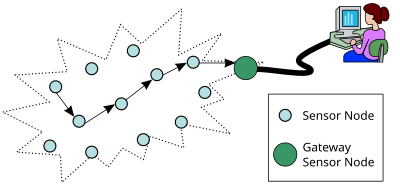 A wireless sensor network is a collection of nodes organized into a cooperative network [10]. Each node consists of processing capability (one or more microcontrollers, CPUs or DSP chips), may contain multiple types of memory (program, data and flash memories), have a RF transceiver (usually with a single omni-directional antenna), have a power source (e.g., batteries and solar cells), and accommodate various sensors and actuators. The nodes communicate wirelessly and often self-organize after being deployed in an ad hoc fashion. Systems of 1000s or even 10,000 nodes are anticipated. Such systems can evolutionize the way we live and work.
A wireless sensor network is a collection of nodes organized into a cooperative network [10]. Each node consists of processing capability (one or more microcontrollers, CPUs or DSP chips), may contain multiple types of memory (program, data and flash memories), have a RF transceiver (usually with a single omni-directional antenna), have a power source (e.g., batteries and solar cells), and accommodate various sensors and actuators. The nodes communicate wirelessly and often self-organize after being deployed in an ad hoc fashion. Systems of 1000s or even 10,000 nodes are anticipated. Such systems can evolutionize the way we live and work.
Currently, wireless sensor networks are beginning to be deployed at an ccelerated pace. It is not unreasonable to expect that in 10-15 years that the world will be covered with wireless sensor networks with access to them via the Internet. This can be considered as the Internet becoming a physical network. This new technology is exciting with unlimited potential for numerous application areas including environmental, medical, military, transportation, entertainment, crisis management, homeland defense, and smart spaces.
Since a wireless sensor network is a distributed real-time system a natural question is how many solutions from distributed and real-time systems can be used in these new systems? Unfortunately, very little prior work can be applied and new solutions are necessary in all areas of the system. The main reason is that the set of assumptions underlying previous work has changed dramatically. Most past distributed systems research has assumed that the systems are wired, have unlimited power, are not real-time, have user interfaces such as screens and mice, have a fixed set of resources, treat each node in the system as very important and are location independent. In contrast, for wireless sensor networks, the systems are wireless, have scarce power, are real-time, utilize sensors and actuators as interfaces, have dynamically changing sets of resources, aggregate behavior is important and location is critical. Many wireless sensor networks also utilize minimal capacity devices which places a further strain on the ability to use past solutions.